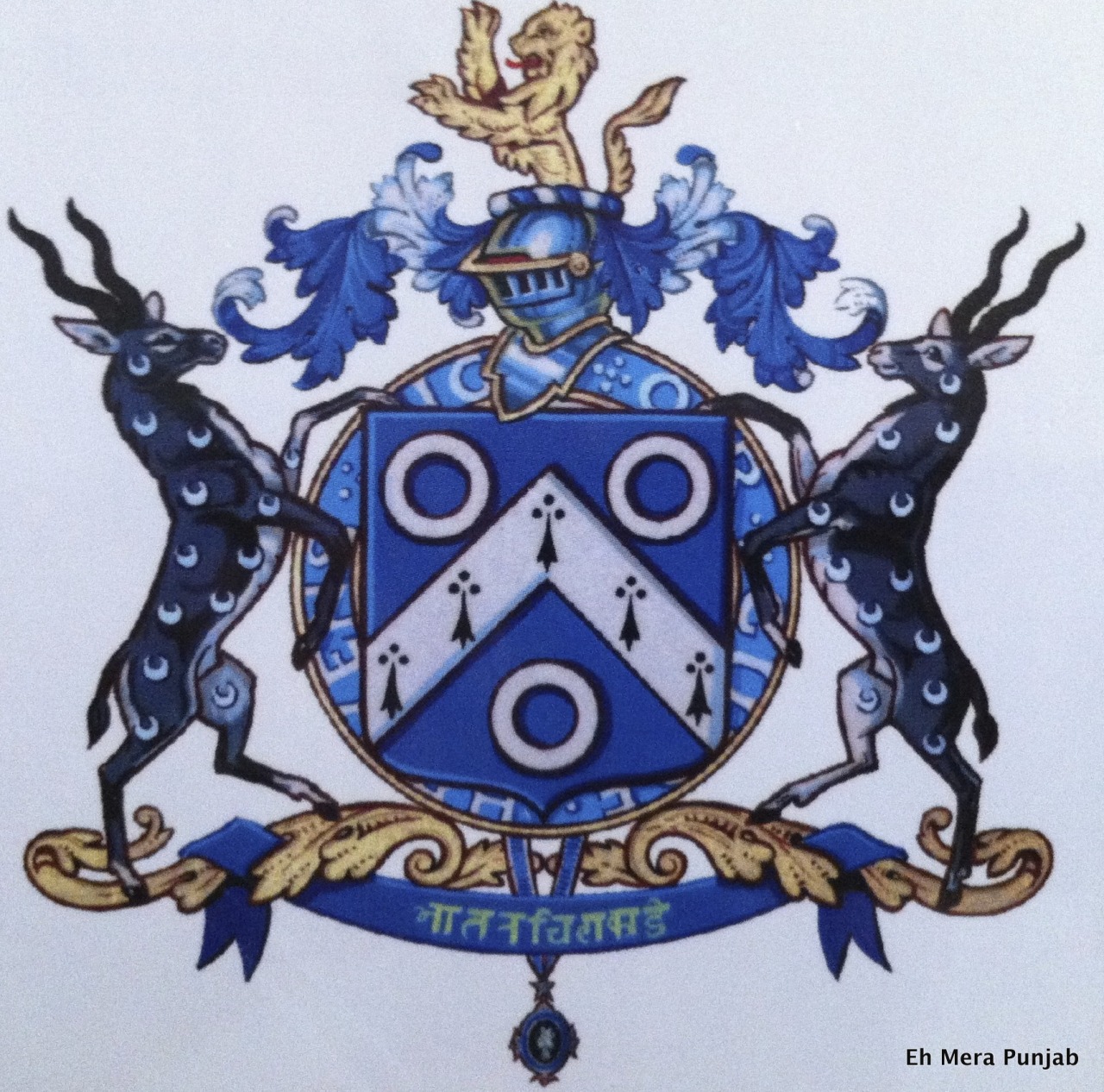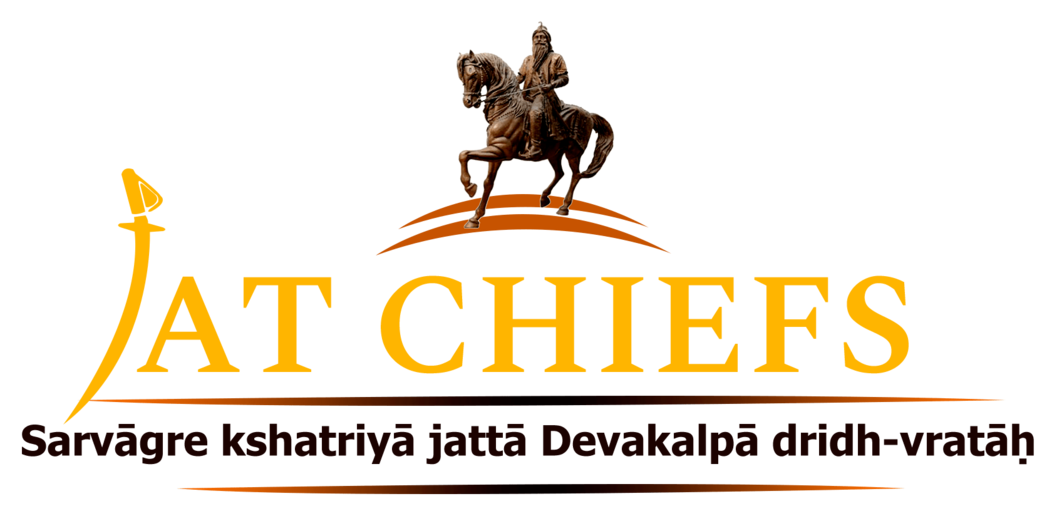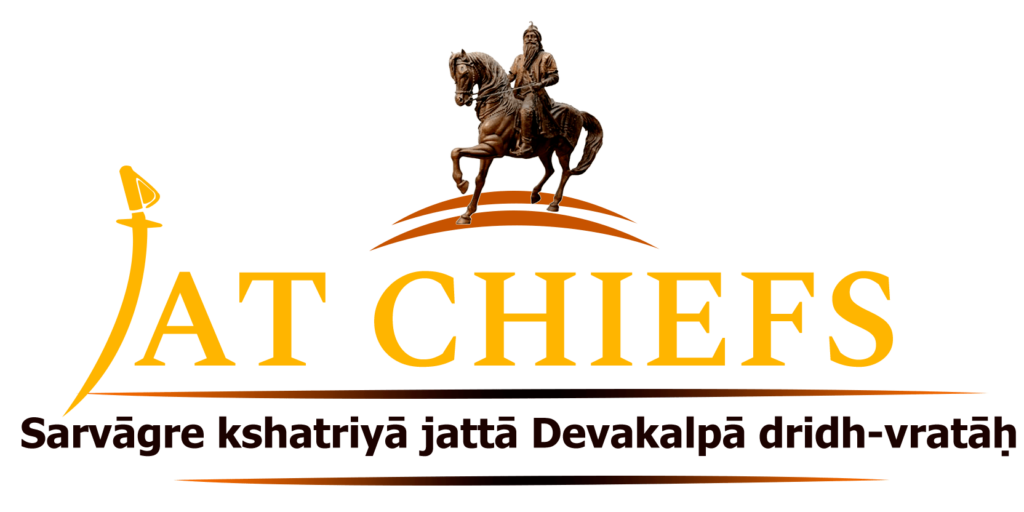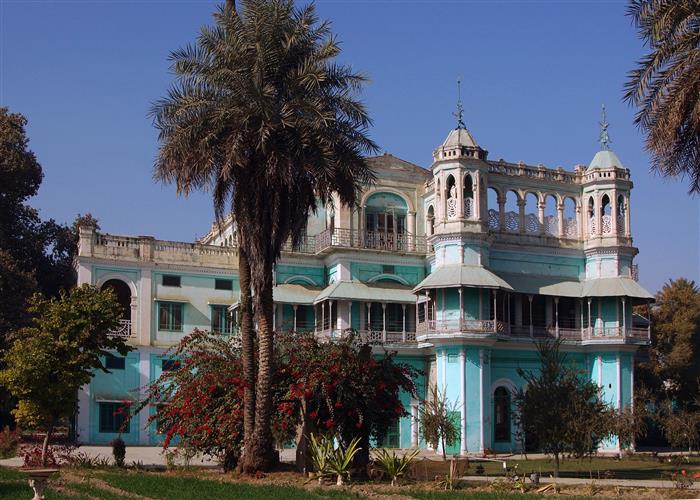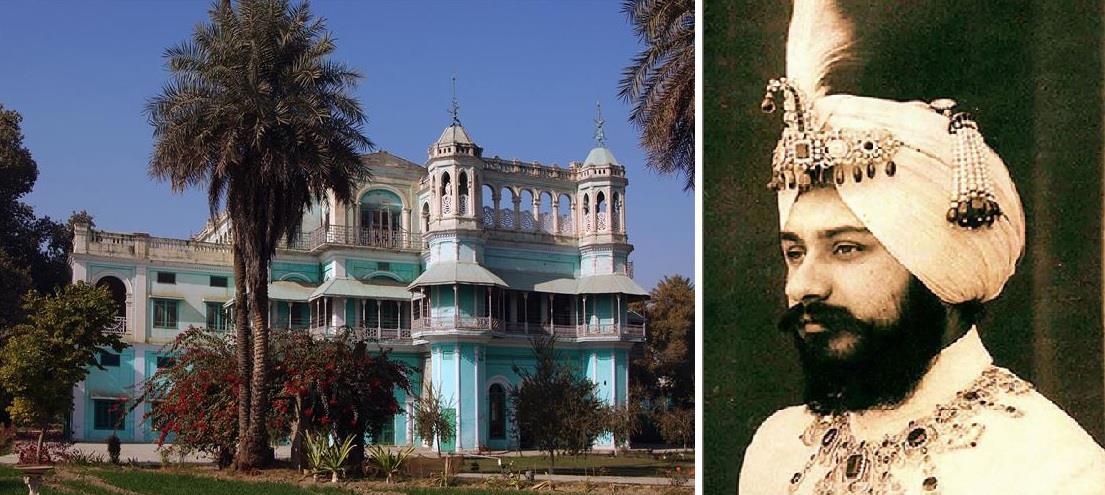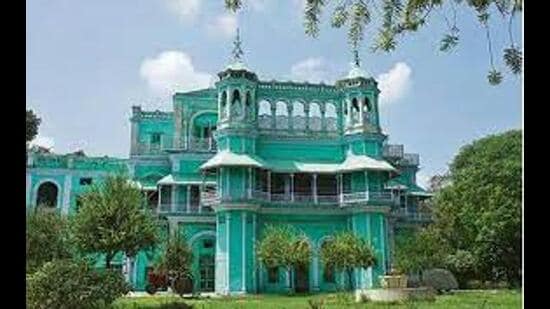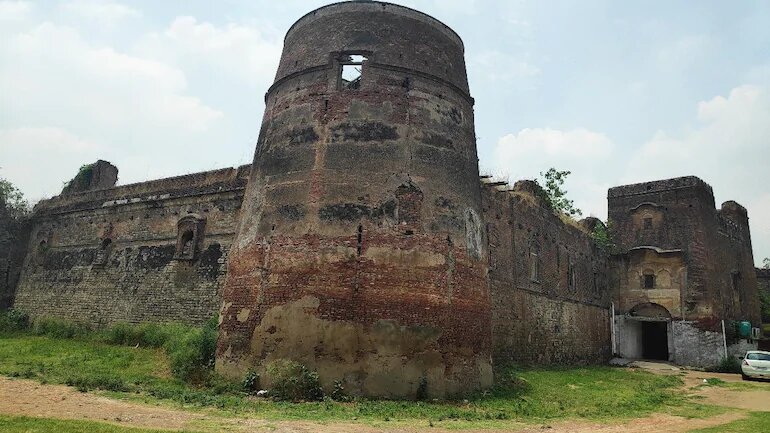History

Flag of Faridkot
For early history see Sidhu Dynasty The Maharaja of Faridkot is the hereditary head of the Brar sept of Sidhu tribe. The Brar refers to the descendants of Rao Brard a Sidhu Jat, who is known for his conquest of Bidowal, Panj Gran, Fakkarsar, Kot Laddu and Lahri from the Muslim Bhatis. He had 2 sons the elder Rao Dhul received the greater kingdom and the younger Rao Paur was given the fort of Bhidowal and other territories. From Rao Dhul, the rulers of Faridkot are descended and from Rao Paur , the rulers Patiala, Jind, Nabha and other Phulkian chiefs are descended. Rao Paur was successed by Rao Vinaypal who conquered the ancient fort of Bhatinda and made it his capital. Under Manik Singh the grandson of Vinaypal, the kingdom stretched from the shores Ghaghar river to the shores of Sutlej. Rao Aasi Singh the grandson of Vinaypal, added murusi territory to the kingdom. Rao Aasi Singh was followed by Fateh Singh, who maintained very cordial relations with the Delhi Sultans to avoid fight with the Muslim Bhatis who by now have grown very powerful. The Chief of the Bhatis with the help of Lodhi Sultans of Delhi, attacked and took control of the Brar kingdom. Sangar the son of Fateh Singh, to avenge the loss of his people helped Babur against Ibrahim Lodhi. Sangar and other Brar Chiefs fought bravely at the battle of Panipat. In return of his service, the Brars were given there old chiefships of Bhatinda, Bidowal and Panjgrain, while Sangar was appointed chaudhary(headmen/Chief) of the Brars.
Chaudhary Sangar founded the town of Chakran , now a deserted village in the district of Kot Kapura and made it his new capital. The story is told that in the reign of the Emperor Akbar, the Muhammadan Bhattis of Sirsa and the Brars quarrelled about their boundaries, and both parties went to Dehli to ask the Emperor to adjudicate between them. Bhallan, the son of Sangar, represented the Burar clan, and Mansur, who was supposed to have influence at Court, one of his daughters being in the royal harem, was the champion of the Bhattis. The Emperor gave them an audience in open Durbar, and, as was customary, presented them with turbans and a dress of honour. Mansur at once began to wind the muslin round his head, when Ballan snatched it from him. A scuffle ensued in which the turban was torn in two. The Emperor was amused at the quarrel and said that his decision would correspond with the length of the pieces of muslin which each had managed to retain. On being measured the fragments were found exactly equal in length, and the Bhattiana and Burar boundary was accordingly laid down on a principle of equality, half the disputed country being given to either claimant. This tradition is preserved by the Burars in a well known line —
Bhallan chira phari Akbar ke Darbar.(Balan tore the turban in Akbar’s Darbar)
In the days of Bhallan the Burars held Kot Kapura, Faridkot, Mari, Mudki and Muktsar, and he was appointed by the Dehli Government Chaudhri or headman of the tribe. On his death, without male issue, Kapura, the son of his brother Lala, succeeded him as Chaudhri. Kapura was born in 1628 and succeeded his uncle in 1643. He was a brave and able man and consolidated the Burar possessions, winning many victories over his neighbours the Bhattis and others.
He founded Sirianwala, now in ruins, but abandoned it for a new residence Kot Kapura, named after himself and which he is reported to have founded at the suggestion of Bhai Bhagtu a famous Hindu ascetic. This town was peopled by traders and others from Kot Isa Khan, and the reputation which Kapura enjoyed for justice and benevolence induced many emigrants to settle in the new town which soon became a place of considerable importance.
Kapura was a malguzar or tributary of Dehli Empire, and appears to have served it With some fidelity, for when Guru Govind Singh visited him in 1704, and begged for his assistance against the Muhammadans, Kapura refused to help him, possibly believing, with many others at that time, that the cause of the new faith was altogether hopeless. Isa Khan, the owner of the fort and village of that name, was Kapura’s great rival and enemy, and watched his growing importance with
the utmost jealousy. The two Chiefs had constant quarrels resulting in much bloodshed, but Isa Khan, finding that he was unable to conquer Kapura by force, determined to subdue him by gentler means, and concluded with him an agreement of perpetual friendship. Then, inviting him to his house, he feasted him, in chivalrous fashion, and assassinated him at the close of the banquet.
Kapura, who was eighty years old at his death in 1708, left three sons, Sukha, Sajja and Makhu, who determined to avenge their father’s murder, and, assembling the clan and obtaining the aid of a strong Imperial force, they attacked Isa Khan, defeated and killed him and plundered his fort.
Sajja, though the second son,* succeeded his father as head of the family, but only survived him twelve years, when his brother Sukha Singh became Chief. He added to his possessions the estates of Rahadatta, Behkbodla, Dharamkot, Karman and Mamdot, and founded the new village of Kot Sukha. To his younger brother, Makhu, the villages Rori and Matta, were assigned from the patrimony, and these are still in the possession of Makhu’s descendants. Sukha died in 1731, aged fifty, leaving three sons, Jodh, Hamir and Vir, who for some time lived together in peace, but at length they quarreled and the two younger wished to divide the estate. To this Jodh, the eldest, would not agree, and Hamir and Vir then asked assistance from some of the Sikh Chiefs then rising to power. Sirdars Jassa Singh Ahluwalia, Kapur Singh Faizullapuria, Jhanda Singh Bhangi and Krora Singh, founder of the misl of that name. These were ready enough to interfere and, crossing the Satlej in force, compelled Jodh to assign the district of Mari Mustafa to Vir, and Faridkot to Hamir, retaining for himself Kot Kapura, with five villages known as the “Kharch Sirdari”, “ the excess usually allowed the eldest son, to support the honor of the Chiefship, in families in which the rule of equal partition ordinarily prevails. The confederate Chiefs then induced the brothers to embrace Sikhism, and having caused them to receive the “pahal” or Sikh baptism, recrossed the river.
Sirdar Hamir Singh was thus the first independent Chief of Faridkot. His brother Jodh Singh, in 1766, erected a new fort at Kot Kapura and almost rebuilt the town ; but his oppression was so great that the inhabitants left it, and the artizans, who had been renowned for their skill and industry, emigrated to Lahore, Amritsar and Pattiala. With Raja Amar Singh, of this last named State, he was constantly engaged in hostilities ; and, in 1767, the Raja having found at the suggestion of the Chief’s brother, a satisfactory pretext for a quarrel, marched to Kot Kapura with a strong force and prepared to invest the fort, when Jodh Singh and his son, advancing too far beyond the walls, fell into an ambuscade laid by the Pattiala troops and was killed, fighting gallantly to the last, his son Jit Singh being mortally wounded.
Jodh Singh was succeeded by his son Tegh Singh who appears to have been a man of very small intelligence. He continued the family feud with Pattiala, and avenged his father’s death by massacring all the inhabitants, men, women and children of the four Jalal villages who were in the pay of Pattiala and by whom Jodh Singh had been slain. Hamir Singh of Faridkot joined in this expedition, but – shortly afterwards quarreled with his nephew who refused submission to him, and taking him prisoner confined him in the Faridkot fort. The Phulkian Chiefs, however, used all their interest to get him set at liberty, which Hamir Singh only consented to do on condition that he would never leave his town of Kotkapura. The result was the utter disorganization of the estate.
The zamindars, unable to obtain justice, refused to pay revenue, and robbery and violence were everywhere prevalent, while Maha Singh Sarai, brother-in-law of the Pattiala Chief, seized Mudki and eighteen neighbouring villages.
The end of Tegh Singh was very tragical He had been for long on the worst of terms with his son Jaggat Singh, who, in 1806, set fire to the house in which his father was residing, and a large quantity of powder having been stored in the vaults beneath, the house was utterly destroyed and the Chief killed by the explosion. The guilty son did not long enjoy the lands of which he thus became possessed. The next year, 1807, his elder brother, Karam Singh, calling Diwan Mohkam Chand to his assistance, defeated him and took possession of the district, but the Diwan and his master Maharaja Ranjit Singh had no intention of restoring it to the rightful owner, and Kotkapura the Maharaja kept for himself, giving five Jalal villages to the Raja of Nabha. The villages of Mudki, which Maha Singh had seized, Ranjit Singh also retained, leaving to Maha Singh shares in two only, Patli and Hukumatwala In 1824, Jaggat Singh made an attempt to recover the estate and drove the Lahore garrison out of Kotkapura, but he was unable to hold it, and was compelled to surrender it after twenty days. He then endeavoured to make his peace with Lahore, and gave his elder daughter in marriage to Sher Singh, the Maharaja’s reputed son ; but the following year, 1825, he died without male issue. The descendants of Karam Singh, the elder brother are still living, but are of no political importance.
It is now necessary to return to the younger branch of Faridkot, represented by Hamir Singh, who, in 1763, received that estate as his share of the patrimony. The town had been founded some time before and named after a celebrated saint, Baba Farid, but Hamir Singh enlarged it, inducing traders and artizans to people it, and built a brick fort for its protection. He had two sons, Dal Singh and Mohr Singh, the former of whom was of an untraceable disposition, and rebelled against his father who suspected that Mohr Singh, the younger brother, was also concerned in the plot. He, accordingly called them both before him to test their temper directed each to fire at the leg of the bed on which he was reclining, with their muskets, or, according to other accounts, to shoot an arrow at it. Dal Singh fired without hesitation and split the leg of the bed ; but Mohr Singh refused, saying that guns were fired at enemies and not at friends. This conduct so pleased the Chief that he declared Mohr Singh his heir, and banished Dal Singh altogether from Faridkot, assigning for his support the villages of Dhodeki, Malloh and Bhalur.* This selection of Mohr Singh as his successor, created a deadly feud between the brothers, and Mohr Singh besieged his rival in Dhodeki. But the latter managed to hold his own, and, calling to his assistance the Nishanwala Chief, defeated his brother and compelled him to return to Faridkot.
Sirdar Hamir Singh died in 1782, and Mohr Singh succeeded him. The new Chief was an incapable, debauched man, and paid no attention to the administration of his estates, several of which, Abuhar, Karmi and Behkbodla were seized by his neighbours. He married a daughter of Sirdar Sobha Singh of Man in Jhind, by whom he had a son Char Singh, or as he is generally known, Charat Singh, and who, accordingly to the almost invariable practice of the family, rebelled against his father. The origin of the quarrel was as follows.
Mohr Singh had another son, Bhupa, born of a Muhammadan concubine, Teji, of whom he was passionately fond ; and this boy had a far larger share of his father’s love and attention than the legitimate son, who regarded his rival with the greatest jealousy and dislike. On one occasion the Chief was setting out on an expedition towards Philor, and told Bhupa to accompany him. The spoiled child refused unless his father allowed him to ride the horse on which his brother always rode and on which he was then mounted. Mohr Singh ordered Charat Singh to dismount and give Bhupa the horse. This insult, though an unintentional one, sank deep into the heart of Charat Singh. He could not endure that he, the legitimate son, should be slighted for the son of a slave girl, and determined on revenge.
Charat Singh rebelled against his father – With Kalha and Diwan Singh, his advisers, he formed a conspiracy to dethrone his father ; and during Mohr Singh’s absence, he surprised the Faridkot fort and put Teji, his father’s mistress, to death. Sirdar Mohr Singh, hearing of what had happened, hastily collected a large body of peasants and attempted to recover the fort, but he was repulsed with loss and retired to the village of Pakka, some four miles distant. Here he was surrounded by the troops of his rebel son, and, after a fruitless resistance, was taken prisoner and sent to Sher Singhwala, a village belonging to the father-in-law of Charat Singh, in which he was confined for a considerable time. At
length, Sirdar Tara Singh Gheba, a powerful Chief, interfered in his behalf and induced Charat Singh to set him at liberty, although he refused to aid Mohr Singh against his son. After this, Mohr Singh made more than one attempt to recover his authority in Faridkot, but without success, and he died, an exile, in 1798.
The fortunes of Sirdar Charat Singh – Sirdar Charat Singh now considered himself safe from attack and reduced the number of his troops. The Pattiala State, his old enemy, was not likely to attack him, for he had repulsed an attack of the famous Diwan Nanun Mal, Minister of Pattiala, during the minority of Raja Sahib Singh, with some loss, and had acquired a great name for courage. But he had forgotten to number among his enemies his disinherited uncle, Dal Singh, who was only waiting an opportunity to regain his lost possessions, and, in 1804, having collected a small body of followers, he attacked the Faridkot fort by night and obtained possession. Charat Singh was surprised and killed, and his wife and three children, Gulab Singh, Pahar Singh and Sahib Singh, barely escaped with their lives.
Sirdar Dal Singh only enjoyed his success for a single month.The children of the murdered Chief were very young, the eldest being no more than seven years of age : but they had many friends, the most able of whom was their maternal uncle Fouju Singh, one of the Sirdars of Sher Singhwala, and, moreover, Dal Singh was generally hated for his tyranny. A plot to assassinate him was formed, and Fouju Singh, with a few armed men, penetrated at night to the apartment of Dal Singh, where he was sleeping with two or three attendants, and killed him. Then they beat a drum, which was the signal for the friends of the young Gulab Singh to bring him into the fort. There he was declared Chief without opposition, and his uncle Fouju Singh was appointed Diwan or Minister. The affairs of the little State were conducted with tolerable efficiency for some time, until Diwan Mohkam Chand the Lahore General invaded the Cis-Satlej territory in the cold season of 1806-7. He seized Zira, Buria, Mokatsar, Kotkapura and Mari, which had been assigned to Vir, the youngest son of Sukha, but which had fallen into the hands of the brother-inlaw of Tara Singh Gheba. The Diwan then marched against Faridkot summoning the garrison to surrender, and, on their refusal, besieged the fort. The garrison trusted more to their position than to their numerical strength. Faridkot was situated in the true desert, and the only water for a besieging army was to be found in a few pools filled with rain water and scattered round the place, and these the besieged filled with the branches of a poisonous shrub, which so affected the water as to give the Lahore troops the most violent purging, and the General had no other resource than to raise the siege. He contrived, however, to exact a tribute of Rs. 7,000 from Fouju Singh, and in his heart resolved to conquer Faridkot on the first favourable opportunity. This opportunity was not long in arriving,* While Mr. Melcalfe, the Agent of the British Government, who had been sent to the Maharaja to conclude a treaty, offensive and defensive, against France, was in his camp, Ranjit Singh of Lahore crossed the Satlej with his whole army, on the 26th September 1808, and marched against Faridkot. He himself halted at Khai, and sent forward an advanced guard to which the fort surrendered without resistance, for the garrison knew that the Maharaja was present in person with the army, and his reputation tion for uninterrupted success was, at this time so great, that he rarely met with direct opposition. A few days afterwards, he himself marched to Faridkot, much elated at finding himself in possession of so fine a fort with so Utile difficulty. Mr. Metcalfe accompanied him, for the Maharaja, under pretense of signing the treaty, drew the British Agent from one place to another, forcing him to be an unwilling spectator of all his Cis-Satlej acquisitions, and although Mr. Metcalfe’s diplomacy was much commended by the Government of the day, there can be little doubt that he was outwitted by the Maharaja, who would have been permitted to retain all his conquests to the south of the Satlej had not the policy of the British Government suddenly undergone a change by the removal of all apprehension of a French invasion.
Before abandoning the fort, Fouju Singh made as good terms for his nephews as were possible, obtaining a grant of five villages to which they retired. The Phulkian Chiefs each tried to obtain the district of Faridkot from the Maharaja. Pattiala had the best claim, for it had once been subject to her authority ; but Raja Jaswant Singh of Nabha and Raja Bhag Singh of Jhind, both bid high. But Diwan Mohkam Chand, who had set his heart on possessing Faridkot ever since his repulse in 1807, was the fortunate grantee, although he had to pay for it a large nazrana, or fine.
The restitution demanded by the British Government – When the British Government demanded from the Maharaja the restitution of all his conquests on the left bank of the Satiej, made during 1808 and 1809, Faridkot was the place he surrendered most unwillingly.
To it he pretended to have a special right, firstly, from its being a dependency of Kotkapura, which he had previously conquered; and, secondly, from an alleged promise made by the owners when it was besieged in 1807, that they would, within one month, put themselves under his authority, and that, should they fail to do so, they would consent to undergo any punishment which he might think fit to impose upon them. With regard to the first claim advanced, it is manifest that no right could be maintained on account of any connection between Kotkapura and Faridkot. Ever since the division of the territory among the sons of Sukha, Faridkot had been independent ; more powerful than Kotkapura and in no way subject to it. Even had there been any connection such as that alleged, the Maharaja’s case would have been no stronger, for his seizure of Kotkapura, before he had requested the assent of the British Government to the extension of his conquests beyond the Satlej, could not warrant his seizure of Faridkot after he had made such a request.
The second ground on which the Raja based his right was in some degree more valid, except that its truth could not be ascertained, and the conduct of the garrison and the sudden and forced retreat of Diwan Mohkam Chand seemed to contradict it ; nevertheless, the British Envoy consented to refer the claim of Faridkot being an old conquest for the decision of Government. This proposal did not at all please the Maharaja, who told Mr. Metcalfe that he must consult with the Chiefs of his army on the Satlej respecting the propriety of restoring Faridkot. The Envoy replied that he should consider the Maharaja’s moving to join his army on the Satlej as a declaration of war and quit his Court accordingly.
Diwan Mohkam Chand, at this very time, returned from Kangra, where he had been negotiating with Raja Sansar Chand for the expulsion of the Gurkhas ; and took up his position at Philor, commanding the passage of the Satlej at its most important part, opposite the town of Ludhiana. His inclination was for war with the English whom he hated and suspected, and he did not wish his master to surrender Faridkot, which had been made over to him in jagir. His influence, from his experience and ability, were very great with the Maharaja, and it was Mr. Metcalfe’s firmness alone which at this time prevented a rupture with the English.
Ranjit Singh at length, and with great unwillingness, gave orders for the evacuation of Faridkot. But Diwan Mohkam Chand evaded compliance as long as possible. He wrote to the Maharaja that a British officer had been appointed to proceed to Faridkot, and that it was intended to occupy the place with a British garrison, and urged his master to suspend his order until such time as he could verify the information sent him.* The British Government had no intention of garrisoning the town, but they had determined that it should be surrendered to its original owners, and it was resolved by the Resident of Dehli to compel the restitution by force of arms.
The hot weather was approaching when the British army could not act in the field without great inconvenience, and the immediate march of troops on Faridkot would hasten its surrender if Ranjit Singh really intended it ; or, in case the evil counsels of Diwan Mohkam Chand should prevail, would only precipitate a contest which would, sooner or later, be inevitable. At the last moment, however, the Maharaja shrank from a collision with the stored. English, and, on the 3rd of April, 1809, restored Faridkot to Sirdar Gulab Singh and his brothers. All obstacles to the completion of the treaty between Lahore and the British Government were now removed, and it was signed shortly afterwards. Faridkot remained a princely state under the British Empire until the independence of India.
Genealogy
- Rao Shri Brard, married and had issues with six sons :-
- Rao Dhul(see below)
- Rao Paur(see Patiala)
- Sawal
- Peplu
- Dodhru
- Sairu
- Rao Shri Dhul, married and had issues.
- Rao Vinay Pal
- Kunwar Sahan Pal,
- Kunwar Lakhan Pal, his descendants are called Deonke Sidhus
- Kunwar Ratan Pal, his descendants are settled in the villages of Abloo, Daan Singh Wala, Kotli, Kili, Mehma Sarja and Kundal.
- Rao Shri Vinay Pal, ruler of Bhatinda, recaptured Bhatinda from the Muslim Bhatis.
- Rao Ajit Singh
- Rao Shri Ajit Singh, ruler of Bhatinda, saw several uprising during his regin, married and had issue
- Rao Manik Singh
- Kunwar Kholu
- Kunwar Dhundo
- Kunwar Hindu
- Rao Shri Manik Singh, his kingdom streched from Ghaghar to Sutlej, married and had issues
- Rao Tenda Singh(see below)
- Kunwar Kokhar, left descentant the Kokharke Sidhus
- Kunwar Khakhi, his descendants settled in Barnala in Ilaka Patiala
- Kunwar Pakhu, his descendants founded mauza Pakhu in Ilaka Bhatinda
- Kunwar Salu, left no descentdant
- Kunwar Bahina, his descendants settled east of Ganga
- Kunwar Kanaiya, his descendants lives in Ilaka Majh
- Rao Shri Tenda Singh, ruler of Bhatinda, married and had issues.
- Rao Asi Singh(see below)
- Kunwar Basi Singh, descendant settled east of Yamuna
- Kunwar Hind,
- Kunwar Mud, established the town of Mudki
- Kunwar Kripala, descendant settled near Dholpur
- Rao Shri Asi Singh, ruler of Bhatinda, married and had issues.
- Dhir Singh(see below)
- Rao Shri Dhir Singh, ruler of Bhatinda, married and had issues.
- Rao Fateh Singh(see below)
- Kunwar Kala
- Kunwar Mulk
- Rao Shri Fateh Singh, ruler of Bhatinda, married and had issues.
- Chaudhary Sangar(see below)
- Kunwar Langar
- Kunwar Sahnu
- Kunwar Lahbu
- Chaudhary Shri Sangar Singh, ruler of Chakran(r.1483 – 1530), married and had issue.
- Chaudhary Bhallan (see below)
- Lala, married and had issue
- Chaudhary Kapur Singh(see below)
- Chaudhary Shri Bhullan Singh, ruler of Chalran (r.1530-1643), ruler of Bhatinda, married and had issues , d.1643
- Chaudhary Shri Kapura Singh, ruler of Kot Kapura(r.1643-1708), born 1628, founder of Kot Kapura in 1661, succeeded as chief on the death of his uncle, 1634. Constructed the fort of Kot
Kapura in 1661. Baptised into the Sikh religion by Guru Gobind Singh and was invested with a khanda (broadsword) and dhal (shield) in 1705, married and had issue. He was killed by Nawab Isa Khan Manj in 1708.
- Chaudhary Sajja Singh (see below)
- Chaudhary Sukha Singh (see below)
- Sardar Makhu Singh, ancestor of the families of Rori and Matta.
- Chaudhary Shri Sajja Singh [Sema], ruler of Kot Kapura(r.1708/1710), he was killed sp in battle in 1710.
- Chaudhary Shri Sukha Singh [Sukhia], ruler of Kot Kapura(r.1710/1731), born 1681, Engaged in almost incessant warfare with his Muslim neighbours after the assassination of his father. Installed as Brar Chief in 1720. married and had issueHe died 1731
- Sardar Jodh Singh, ruler of Kot Kapura, He was killed in battle with the Raja of Patiala, outside Kot Kapura, 1767, having had issue two sons
- Sardar Tegh Singh of Kot Kapura 1767/1806, married and had issue. He was blown up in his house by his son, at Kot Kapura, 1806
- Sardar Karam Singh of Duduke Khurd in 1807, incorporated into Nabha in 1807, married and had issue
- Sardar Jagat Singh of Kot Kapura 1806/1807, Seized the chieftaincy by killing his father, 1806. Defeated by the forces of the General Diwan Mohkam Chand, and lost Kot Kapura and all his territories, married and had issue. He died 1825. Rani Pratap Kaur, married 1825, Maharaja Sher Singh of Lahore. She died 23rd August 1857.
- Thakar Singh, born about 1843, adopted in 1847, son of his mothers cousin, Gajja Singh.
- Sardar Jit Singh [aka Amrik Singh], died 1767.
- Sardar Tegh Singh of Kot Kapura 1767/1806, married and had issue. He was blown up in his house by his son, at Kot Kapura, 1806
- Sardar Hamir Singh, ruler of Faridkot(see below)
- Mian Bir Singh of Mari Mustafa
- Sardar Jodh Singh, ruler of Kot Kapura, He was killed in battle with the Raja of Patiala, outside Kot Kapura, 1767, having had issue two sons
- Sardar HAMIR SINGH, 1st Sardar Sahib of Faridkot 1763/1782, he built Faridkot and made it his
capital; married and had issue. He died 1782.
- Sardar Mohar Singh (qv)
- Sardar Dal Singh (qv)
- Sardar MOHAR SINGH, 2nd Sardar Sahib of Faridkot 1782/1798, he was deposed by Sardar
Charat Singh and died in exile; married a daughter of Sardar Sobha Singh of Mán in Jind, and had issue, as well as further issue by a Muslim lady, named Teji. He died 1798.
- Sardar Charat Singh (qv)
- Bhupa Singh (by Teji)
- Sardar CHARAT SINGH, 3rd Sardar of Faridkot, elder son of Sardar Mohar Singh Brar, Sardar of Faridkot, Deposed and expelled his father,and married a sister of Kang Jat Chief Sardar Fauju Singh, of Kamiana, Chief Minister of Faridkot and guardian to his nephew 1804-1808 and 1809. He was k. by his uncle, Sardar Dal Singh, at Faridkot, 1804, having had issue, four sons :
- Sardar Gulab Singh (qv)
- Raja Pahar Singh (qv)
- Sardar Sahib Singh, died 1831.
- Sardar Mehtab Singh
- Sardar DAL SINGH, 4th Sardar of Faridkot, elder son of Sardar Hamir Singh Brar, Sardar of Faridkot. privately. Disinherited by his father and expelled from the state but never accepted his position. Succeeded on the death of his nephew, 1804 and reigned for four months. He was killed at Faridkot by Sardar Fauju Singh, 1804.1804-1807 1809-1826 Sardar Gulab Singh Brar, Sardar of Faridkot. b. at Qila Mubaraqat, Faridkot, ca. 1797, eldest son of Sardar Charat Singh Brar, Sardar of Faridkot,Succeeded on the death of his grand uncle, 1804. Expelled by Bhatti Jat ruler Maharaja Ranjit Singh who granted Faridkot to General Diwan Mohkam Chand, October 1808. Restored after British intervention 3rd April 1809. m. (first) Sardarni Dharam Kaur, Mbr. Council of Regency 1826-1827, daughter of Sardar Jodh Singh Kaleka, of Jamma, in Patiala state. m. (second) a daughter of Gill Jat Chief Sardar Sher Singh Gill of Gholia, in the Moga territory. He was killed at Qila Mubaragat, Faridkot, 5th November 1826, and next Chief was Gulab Singh , having had issue, an only surviving son by his first wife.
- Sardar GULAB SINGH, 5th Sardar Sahib of Faridkot 1804/1826, born about 1797, Faridkot was attacked by Diwan Mokham Chand in 1806-1807, acting on behalf of Maharaja Ranjit Singh, but
the fort was only taken two years later by the Maharaja himself; married 1stly, a daughter of Sardar Jodh Singh Kaleka of Jamma in Patiala, married 2ndly, Sardarni Dharam Kaur, daughter of Sardar Sher Singh Gill of Gholia in Moga district, and had issue. He was assassinated on 5th November 1826, apparently with the connivance of his brother, Sahib Singh.
- Sardar Attar Singh, Sardar of Faridkot (s/o Rani Dharam Kaur)
- Sardar ATTAR SINGH, 6th Sardar Sahib of Faridkot 1826/1827, born 1822, he died in August 1827.
- Raja PAHAR SINGH, 7th Raja of Faridkot 1827/1849, born 1800, an able and liberl-minded ruler, who devoted himself to the improvement of his possessions; when the first Sikh war broke out in 1845, he attached himself to the English, using his utmost exertions to collect supplies and
carriages, and furnishing guides for the army, afterwards he received as his reward the title of Raja in 1846, together with half the territory confiscated from the Raja of Nabha, and in this
obtained possession once more of Kot-Kapura, the ancestral seat of his family, married 1stly, Rani Chand Kaur, daughter of Sardar Samand Singh Dhaliwal of Dina, married 2ndly, Mai Desu,
daughter of a Gill zamindar of Mudki, married 3rdly (by chaddar dálna) in 1831, the widow of his younger brother, married 4thly, Rani Jas Kaur, daughter of Rai Singh of Kaleka in Patiala, and had issue. He died in April 1849 (#2).
- Raja Wazir Singh (by Rani Chand Kaur)(qv)
- Rajkumar Dip Singh (by Mai Desu), died 1845.
- Rajkumar Anokh Singh (by Mai Desu), died 1845.
- Raja WAZIR SINGH Brar Bans Bahadur, 8th Raja of Faridkot 1849/1874, born 1828, a devout Sikh, he received the rites of initiation at Gurdwara Sri Hazur Sahib, Nanded, he built new villages and introduced several reforms in the land revenue system; he joined the English in the second Sikh
war, and greatly distinguished himself during the Mutiny of 1857 by seizing mutineers, guarding the ferries over the Sutlej, and attacking a notorious rebel named Sham Das, whose village he
destroyed, his troops served with credit under General Van Cortlandt in Sirsa and elsewhere, for these services he was granted the title of Brar Bans Raja Sahib Bahadur, a khilat of increased
value and a salute of eleven guns; he was also exempted from the service of ten horsemen, which he previously had to provide and in 1862 he received a sanad conferring the right of
adoption, married 1stly, Rani Ind Kaur, daughter of Sardar Sham Singh Mann of Munsab, married 2ndly, a daughter of Basawa Singh of Raipur, married 3rdly, a daughter of Sardar Gajja
Singh of Lahore, married 4thly, 1845, the widow of his brother Anokh Singh, and had issue. He died 22nd April 1874 (#1) at Kurukshetra.
- HH Farzand-i-Saadat-i-Nishan-i-Hazrat-Kaisar-i-Hind Raja Bikram Singh Brar Bans Bahadur (by Rani Ind Kaur)(qv)
- HH Farzand-i-Sadaat-i-Nishan-i-Hazrat-i-Kaisar-i-Hind Raja BIKRAM SINGH Brar Bans Bahadur, 9th Raja of Faridkot 1874/1898, born January 1842; he succeeded to the gadi on 22nd April 1874, he modernized the state administration and employed retired British officials with
experience and in 1875 set up offices and courts on the British model and adopted British law, he opened schools and charitable hospitals, constructed dharamsalas and rest houses for
travellers, established free kitchens at Faridkot, Thanesar and Amritsar, Sanskrit pathshalas, or schools were started where free food was served to the students, he was a patron of the Khalsa
Diwan in Amritsar, he was appointed a Fellow of the Punjab University to which he donated large sums of money, he was granted the title of Farzand-i-Sa'adat-Nashan-i-Hazrat-i-Kaisar-i- Hind; married the daughter of Raja Nahar Singh of Ballabgarh and had issue. He died 8th August 1898 , had issues with two sons and one daughter -
- HH Farzand-i-Sadaat-i-Nishan-i-Hazrat-i-Kaisar-i-Hind Raja Balbir Singh Brar Bans Bahadur (qv)
- Kanwar Gajendra Singh Sahib Bahadur, of Dhana (s/o Rani Bishan Kaur),was done there education from Aitchison College Lahore. Granted several villages in Dhana in jagir, 1898. He d. 1900, having had issue, two sons and daughter :
- HH Farzand-i-Sadaat-i-Nishan-i-Hazrat-i-Kaisar-i-Hind Raja Brijindar Singh Brar Bans Bahadur (qv)
- Rajkumari (name unknown), married 1913, HH Shri Maharajah Sir Brijendra Sawai Kishan Singh Bahadur Jang, 12th Maharajah of Bharatpur. She died 1929.
- Kunwar Shive Inder Singh Brar
- Rajkumari Bibiji Balwant Kaur Sahiba [Kunwarani Balwant Kaur, of Mursan], was Married to Thenua Jat Kanwar Baldeo Singh, second son of Sri Raja Ghansham Singh Bahadur, Raja of Mursan, in the Aligarh district of UP
- H.H. Farzand-i-Sadaat Nishan Hazrat-i-Kaiser-i-Hind Raja Balbir Singh, Brar Bans Sahib Bahadur, Raja of Faridkot. b. at the Qila Mubaraqat, Faridkot, 30th August 1869, elder son of H.H. Farzand-i-Saadat-i-Nishan-i-Hazrat-i-Kaiser-i-Hind Raja Bikram Singh, Brar Bans Sahib Bahadur, Raja of Faridkot, by his second wife, a daughter of Sardar Partab Singh Rallawala, of Patiala state, educ. privately. Became Heir Apparent on his father's accession to the gadi and formally invested with the title of Tikka Sahib, at the Qila Mubaraqat, Faridkot, 22nd April 1874. Succeeded on the death of his father, 20th August 1898. Installed on the gadi, at the Raj Mahal, Faridkot, 16th December 1898. He accepted a degree of government supervision over state affairs during the first few years of his reign. Invested with full ruling powers in November 1904. Attended the Coronation Durbar at Delhi in 1903. Author of "Ek Raja aur us Kar Daura". H was Recived KIH silver medal (1877), and Delhi Durbar gold medal (1903). m. (first) 1886, H.H. Rani Suraj Kaur Sahiba, younger daughter of Raja Bhagwan Singh, Raja of Manimajra, in the Ambala district of the Punjab, by his second wife, Rani Narain Kaur. m. (second) H.H. Rani Hardit Kaur Sahiba, from Bapiana. He d.s.p.m. at the Raj Mahal, Faridkot, 11th February 1906 (succ. by his adopted son and nephew), having had issue, several daughters, including :
- Rajkumari Bibiji ... Kaur Sahiba. She d. young.
- Rajkumari Bibiji Chattar Kaur Sahiba. m. Sardar Prithipal Singh Mann, of Manawala, in the Sheikhupura district of Punjab. She had issue, one son and two daughters:
- Sardar Harpal Singh Mann, of Kothi Gulfishan, Bassi Pathana, Fatehgarh district of Punjab. He had issue, two sons and one daughter:
- Colonel Parampal Singh Mann. He had issue:
- Kunwar Amanpal Singh Mann.
- Sardar Mahipal Singh Mann. DSP Punjab Police 1986-1987, AIG Traffic. He had issue, a son.
- Pushppal Kaur Mann.
- Colonel Parampal Singh Mann. He had issue:
- Bibi Rupinder Kaur. b. 15th February 1929. MLA Punjab. m. ... Singh (d. 1992), of Lahore, Punjab. he died at Sacramento, California, USA, 10th April 2011, having had issue, two daughters.
- Bibi Punum Kaur. She died young from tuberculosis as a teenager.
- Sardar Harpal Singh Mann, of Kothi Gulfishan, Bassi Pathana, Fatehgarh district of Punjab. He had issue, two sons and one daughter:
- Rajkumari Bibiji Rajendra Kaur Sahib [H.H. Maharani Sri Maji Sahiba Bibiji Rajendra Kaurji]. b. at Qila Mubaraqat, Faridkot, 190x (youngest daughter), educ. privately. Colonel-in-Chief Brijendra Elephant Artillery. married at the Qila Mubaraqat, Faridkot, 3rd March 1913, Colonel H.H. Maharaja Shri Brijendra Sawai Sir Kishan Singhji Bahadur Jang, Maharaja of Bharatpur, KCSI (b. at Moti Mahal, Bharatpur, 4th October 1899; d. at Agra, 27th March 1929), elder son of H.H. Maharaja Shri Brijendra Sawai Ram Singhji Bahadur Jang, Maharaja of Bharatpur, by his second wife, H.H. Maharani Sri Maji Sahiba Bibiji Girraj Kaurji, CI, sometime Maharani Regent of Bharatpur, a daughter of a Zamindar of Deoli. She was died at Deeg, 18th August 1929, having had issue, four sons and three daughters -
- Major H.H. Farzand-i-Saadat-i-Nishan-i-Hazrat-i-Kaiser-i-Hind Maharaja Brij Indar Singh Brar Bans, Bahadur,Maharaja of Faridkot. b. at Faridkot, 26th October 1896, elder son of Kunwar Gajendra Singh Sahib Bahadur, educ. Aitchison Coll, Lahore. Adopted by his paternal uncle, H.H. Farzand-i-Sadaat Nishan Hazrat-i-Kaiser-i-Hind Raja Balbir Singh, Brar Bans Sahib Bahadur, Raja of Faridkot. Succeeded on his death, 11th February 1906. Installed on the gadi, at the Raj Mahal, Faridkot, 15th March 1906. Reigned under a Council of Regency until he came of age and was invested with full ruling powers, November 1916. Granted the personal title of Maharaja in recognition of his services during the Great War, 1st January 1918. Hon Major IA 1/1/1918. Rcvd: Delhi Durbar medal (1911). married H.H. Rani Mahinder Kaur Sahiba, from Sujadpur, Punjab. He was died at the Raj Mahal, Faridkot, 23rd December 1918, having had issue, two sons :
- H.H. Farzand-i-Saadat-i-Nishan-i-Hazrat-i-Kaiser-i-Hind Raja Sir Harinder Singh, Brar Bans Sahib Bahadur, Raja of Faridkot - see below.
- Colonel Kunwar Shri Manjitinder Singh Sahib Bahadur. born at Qila Mubaraqat, Faridkot, 22nd February 1916, educ. Aitchison Coll, Lahore. Lt-Col Faridkot State Forces 1944, President Exec Council 1947-1948, prom Col 1948, MLA for Kot Kapura-Jaitu in the PEPSU state assembly 1951-1957. Horse breeder and trainer.Member Madras Race Club. Rcvd: King George V Silver Jubilee (1935), and King George VI Coron (1937) medals. m. (sep.) Kunwarani Jagdish Kaur Sahiba (b. at Pipri, UP, 1916; d. at Faridkot, 25th January 1996), educ. Queen Mary Coll, Lahore, MLA for Jaitu in the Punjab state assembly 1957-1962, great-great-granddaughter of Shahzada Peshawara Singh Bahadur, of Lahore, and daughter of Sardar Gulzar Singh, of Pipri, in the Bahraich district of UP, by his wife, Rani Rajendra Pal Kaur Sahiba. He d. at the Council House, Faridkot, 1999, having had issue, two sons and one daughter:
- Kunwar Bharatinder Singh Sahib Bahadur [Prince Michael], who succeeded as H.H. Farzand-i-Saadat-i-Nishan-i-Hazrat-i-Kaiser-i-Hind Raja Shri Bharatinder Singh, Brar Bans Sahib Bahadur, Raja of Faridkot - see below.
- Captain Kunwar Dashmesh Inder Singh Sahib Bahadur [Prince Victor]. born at Faridkot, 1947, education Bishop Cotton Sch, Simla. IAF retd 1975. He d. unm. 1977.
- Rajkumari Bibiji Devinder Kaur Sahiba [Princess Wendy]. b. at Faridkot, 1942. Visitors’ Guide at the United Nations HQ in New York 1966-1970. m. at Manhattan, New York, USA, 29th January 1970 (div.), Andreas John Farmakis (born in Greece, 7th April 1935; m. second, Christina E Mantini), graphic designer, Mbr International Punjab society, Friends of Rogers Memorial Library, etc, an American citizen of Greek origin. She d. at the Post Graduate Inst of Medical Education & Research, Chandigarh, Punjab, 6th January 2009, having had issue, one daughter.
- Colonel H.H. Farzand-i-Saadat-i-Nishan-i-Hazrat-i-Kaiser-i-Hind Raja Sir Harinder Singh, Brar Bans Sahib Bahadur, Raja of Faridkot, KCSI (1.1.1941). b. at Qila Mubaraqat, Faridkot, 29th January 1915, elder son of Major H.H. Farzand-i-Saadat-i-Nishan-i-Hazrat-i-Kaiser-i-Hind Maharaja Brij Indar Singh Brar Bans, Bahadur, Raja of Faridkot, by his wife, H.H. Rani Mahinder Kaur Sahiba, educ. Aitchison Coll, Lahore. Succeeded on the death of his father, 23rd December 1918. Reigned under a Council of Regency, until he came of age and was invested with full ruling powers, at Qila Mubaraqat, Faridkot, 17th October 1934. Cmsnd as temp Hon 2nd-Lieut IA 2/5/1933, attached The Poona Horse 2/5/1933-15/12/1933, prom Hon Lieut IA 17/10/1934, attached 1st Btn (King George V’s Own), 11th Sikh Regt, IA, served Waziristan 1937, prom Hon Capt 4/7/1941, prom Hon Maj 1/1/1944, prom Hon Lieut-Col 15/8/1945, and prom Hon Col 11/10/1946. Hon Col The Sikh Light Infantry, IA 3/3/1947-1989, Hon Col King George V’s Own Bengal Engineer Group, RIE, and Bombay Engineer Group 18/1/1951-1989. Colonel-in-Chief Faridkot State Forces 23/12/1938-1951. Mbr National Defence Council of India, Standing Cttee of the Chamber of Princes, and MLA PEPSU. Merged his state into the PEPSU, 5th May 1948. The GOI amended the Indian Constitution to remove his position as a "ruler" and his right to receive privy-purse payments, 28th December 1971. Hon Past Grand Master 1974, OSM 1971, Grand Lodge of India; District Grand Master for North India United Grand Lodge of England 1977-1989. Chair Maharawal Khewaji Trust 1981-1982. Patron Indian Science Congress. Hon Mbr United Service Institution of India. Mbr Delhi Gymkhana Club, Delhi Golf Club, etc. Rcvd: King George V Silver Jubilee (1935), King George VI Coron (1937), IGS (with Waziristan clasp 1937), 1939/45 and Burma stars, British War, Defence (1945), and Indian Independence (1948) medals. m. at Qila Mubaraqat, Faridkot, 12th February 1933, H.H. Rani Narinder Kaur Sahiba (d. 19th April 1986), second daughter of Sardar Bahadur Bhagwant Singh, of Bhareli, in the Ambala district of the Punjab, by his second wife, Sardarni Kuldeep Kaur, daughter of Sardar Balwant Singh, of Attari, in the Amritsar district of the Punjab. He d. at Batra Hospital & Medical Research Centre, Tughlakabad, New Delhi, 16th October 1989 (crem. at Shahi Samadhan, Faridkot), having had issue, one son and three daughters :
- Tikka Shri Har Mohinder Singh Sahib Bahadur [Prince David]. b. at Qila Mubaraqat, Faridkot, 22nd October 1937, educ. at the Doon Sch, Dehra Dun, and Cambridge Univ. Punjab state government service 1962-1965. Mbr Delhi Gymkhana Club, Delhi Golf Club, and Pitt Club (Cambridge). He d.v.p. unm. in a motor accident, 10th October 1983 (crem. at Shahi Samadhan, Faridkot).
- Rajkumari Bibiji Amrit Kaur Sahiba [Sadarni Amrit Kaur Harpal Singh]. b. at Qila Mubaraqat, Faridkot, 1933, educ. St Bede’s Coll, Simla, and Punjab Univ, Chandigarh. m. 1951, Major Sardar Harpal Singh Sekhon (b. 4th December 1922), joined Faridkot State Forces 1/12/1942, served in WWII, ADC to Raja Sir Har Inder Singh, joined Faridkot Police 1946, transf to Indian Police Service (IPS) 1954, Deputy Transport Controller (O) Punjab 1966, Inspector (ISP) 94th Btn, Border Security Force (BSF), Deputy Inspector-Gen (DIG) Haryana Police, served in diplomatic assignments in the USA for 3 years, Dir-Gen of Vigilance Haryana State Electricity Brd, rcvd: Police Medal for Meritorious Service (26.1.1976). She had issue, one son and two daughters:
- Kunwar Jaskaran Singh. b. 1955. Settled in Loughton, Essex. m. Beverley (born December 1962), Dir Capital Estates Ltd since 1991, Partner Contrary Curiosity LLP since 2011. He has issue, a son and a daughter:
- Aftab Singh. b. in Essex, 1988. Partner Contrary Curiosity LLP since 2011.
- Aiyna Singh. b. in Essex, 1986.
- Bibiji Simar Kaur [Simar Negi]. Chief Income Tax Cmsnr Delhi. b. 1956. m. Anoop Negi.
- Bibiji Gurveen Kaur [Ms Gurveen H. Singh]. b. 1962, educ. Post Graduate Govt College for Girls-Sector 11 (BA 1982), and Punjab Univ, Chandigarh (LLB 1985). Additional Advocate-Gen Punjab, retd 2012. Snr Partner Gurveen H. Singh Advocates & Solicitors. Mbr Punjab Haryana High Court Bar Assoc 1985
- Kunwar Jaskaran Singh. b. 1955. Settled in Loughton, Essex. m. Beverley (born December 1962), Dir Capital Estates Ltd since 1991, Partner Contrary Curiosity LLP since 2011. He has issue, a son and a daughter:
- Rajkumari Bibiji Bibiji Deepinder Kaur Sahiba [Princess Bunty] [Maharaniadirani Deepinder Kaur Sahiba, of Burdwan]. b. at Qila Mubaraqat, Faridkot, 17th July 1936. Chair Maharawal Khewaji Trust. m. at Qila Mubaraqat, Faridkot, 14th December 1959, Maharajadhiraja Shri Saday Chand Mehtab Bahadur of Burdwan, eldest son of The Hon Maharajadhiraja Shri Sir Uday Chand Mehtab Bahadur of Burdwan, KCIE, by his wife, Maharani Radharani Devi, of Amritsar, Punjab.
- Rajkumari Bibiji Maheepinder Kaur Sahiba [Princess Anne]. born at Qila Mubaraqat, Faridkot, 19th September 1949, education New Delhi and Tara Hall, Simla. Vice-Chair Maharawal Khewaji Trust. She died. unm. from heart failure, at Kennilworth, Mashobra, near Simla, 26th July 2002 (crem. at Shahi Samadhan, Faridkot).
- H.H. Farzand-i-Saadat-i-Nishan-i-Hazrat-i-Kaiser-i-Hind Raja Shri Bharatinder Singh, Brar Bans Sahib Bahadur, Raja of Faridkot. b. at Faridkot, 1945, eldest son of Colonel Kunwar Shri Manjitinder Singh Sahib Bahadur, sometime president Faridkot Executive Council, by his wife, Rani Jagdish Kanwar Sahiba, eduction Bishop Cotton School, Simla. Sometime tea-planter. Appointed as Heir Apparent with the title of Tikka Sahib on the death of his paternal first cousin, 1983. Succeeded on the death of his paternal uncle as Head of the Royal House of Faridkot, 16th October 1989 (not recognised by the Government of India). Known as Tikka Bharat Inder Singh Brar. married 2nd January 1971, H.H. Rani Braham Prakash Kaur Sahiba [Braham Prakash Kaur Brar] (b. at Faridkot, 20th August 1952), education Barjindra College, Faridkot, United Church of Northern India (UCNI) Girls High School, Dehradun, and Panjabi University , Patiala, Punjab, daughter of Chaudhury Mohan Singh Sukhija, sometime Municipal commissioner Faridkot. He died at Chandigarh, Punjab, 8th January 2017 (crem. at Shahi Samadhan, Faridkot), having had issue, two sons :
- Tikka Shri Amarinder Singh Brar Sahib Bahadur [Prince Battie], who succeeded as H.H. Farzand-i-Saadat-i-Nishan-i-Hazrat-i-Kaiser-i-Hind Raja Shri Amarinder Singh, Brar Bans Sahib Bahadur, Raja of Faridkot
- Kanwar Ravi Inder Singh Brar [Prince Attie Brar]. b. at Faridkot, 25th January 1978, educ. St John’s High Sch, 16 Model Sch, DAV Coll, and Punjab Univ (LLB), Chandigarh, Punjab. Perfume collector. Sec Punjab Youth Congress. Dir S & G Crushers Pvt Ltd since 2013. Mbr The Sjoba Fndn, St John’s Old Boys Assoc (SJOBA), Sikh Military History Forum, etc. m. (first) (div.) ... m. (second) at Shimla (civil) and at the Sankat Mochan Temple, Bagh, Taradevi, HP, 26th September 2015 (relig.), Kanwarani Meenakshi Kumari Sahiba (b. at Simla, 27th June 1966), educ. Loreto Convent, Tara Hall, and St Bede’s Coll, Shimla,fourth daughter of Captain The Hon Raja Shri Virbhadra Singh Sahib Bahadur, Raja of Bashahr, sometime Chief Minister of Himachal Pradesh, by his first wife, Rani Rattan Kumari Sahiba, younger daughter of Raja Rana Digvijay Chand Sahib, Raja Rana of Jubbal.
- H.H. Farzand-i-Saadat-i-Nishan-i-Hazrat-i-Kaiser-i-Hind Raja Shri Amarinder Singh, Brar Bans Sahib Bahadur , 14th Raja of Faridkot and head of Brar clan of Jats since 2017.b. at Faridkot, 13th December 1971, elder son of H.H. Farzand-i-Saadat-i-Nishan-i-Hazrat-i-Kaiser-i-Hind Raja Shri Bharatinder Singh, Brar Bans Sahib Bahadur, Raja of Faridkot, by his wife, H.H. Rani Braham Prakash Kaur Sahiba, educ. St John’s High Sch, Punjab Engineering Coll (PEC) Univ of Technology (B.Eng. 1994), and at the University Business Sch (UBS), Punjab Univ (MBA 1996), Chandigarh, Punjab. Assist Mngr Punjab Wireless Systems Ltd (Punwire) in Karnal 1996-1999, Mngr ICICI Capital Services Ltd in Ludhiana 1999-2001, joined Citibank, N.A. 2001, Mngr in New York 2001-2004 and in San Francisco 2004-2005, Assist Vice-Presdt Punjab Cluster in San Francisco 2005-2006, Branch Head & Assist Vice-Presdt in San Francisco 2006-2007, Vice-Presdt & Citibanking Head for Punjab & Jaipur 2007-2012, etc. m. 1997, H.H. Rani Deepak Kaur Sahiba [Deepak Brar], educ. Government Coll for Girls (GCG), Chandigarh, Punjab, daughter of Sardar Gurdev Singh Sandhu Of Abohar, in th Fazilka district of the Punjab. He has issue, a son and a daughter :
- Tikka Shri Karan Inder Singh Brar Sahib Bahadur [Karan Brar], educ. St John’s High Sch, Chandigarh, Punjab.
- Rajkumari Bibiji Gurmehak Inder Kaur Sahiba [Mannat]. b. 1998, educ. Carmel Convent Sch, Chandigarh, Punjab. Mbr Carmel Ex-Students Association (CESA), was married on 24th November 2024 with Mr. Ishaan Vijh son of Mr. Sandeep Vijh and Mrs . Rinki Vijah at Baikunth Farm by TBD Soonak , Mohali.
- Ruling Princes and Chiefs, Notables and Principal Officials of the Punjab Native States. First edition. Lahore: Printed by the Superintendent, Government Printing, Punjab, 1918.
- "The Golden Book of India"; LETHBRIDGE, Roper, MacMillan & Co., 1893 , p.133
- L.H Griffin, The Rajas of Punjab
